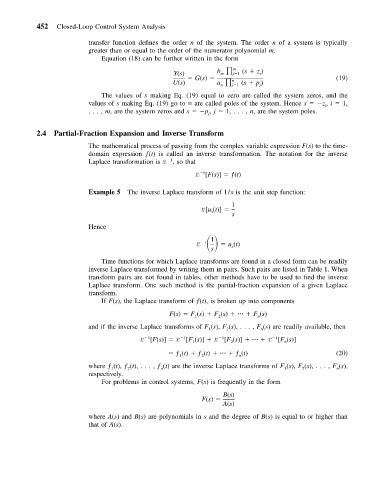Page 461 - Mechanical Engineers' Handbook (Volume 2)
P. 461
452 Closed-Loop Control System Analysis
transfer function defines the order n of the system. The order n of a system is typically
greater than or equal to the order of the numerator polynomial m.
Equation (18) can be further written in the form
m
Y(s) b j 1 (s z )
m
i
G(s) (19)
n
U(s) a j 1 (s p )
n
j
The values of s making Eq. (19) equal to zero are called the system zeros, and the
values of s making Eq. (19) go to are called poles of the system. Hence s z , i 1,
i
..., m, are the system zeros and s p , j 1,..., n, are the system poles.
j
2.4 Partial-Fraction Expansion and Inverse Transform
The mathematical process of passing from the complex variable expression F(s) to the time-
domain expression ƒ(t) is called an inverse transformation. The notation for the inverse
1
Laplace transformation is L , so that
L [F(s)] ƒ(t)
1
Example 5 The inverse Laplace transform of 1/s is the unit step function:
1
L[u (t)]
s
s
Hence
L
1
1
s
s u (t)
Time functions for which Laplace transforms are found in a closed form can be readily
inverse Laplace transformed by writing them in pairs. Such pairs are listed in Table 1. When
transform pairs are not found in tables, other methods have to be used to find the inverse
Laplace transform. One such method is the partial-fraction expansion of a given Laplace
transform.
If F(s), the Laplace transform of ƒ(t), is broken up into components
F(s) F (s) F (s) F (s)
1 2 n
and if the inverse Laplace transforms of F (s), F (s), ..., F (s) are readily available, then
1
2
n
1
1
1
1
L [F(s)] L [F (s)] L [F (s)] L [F (s)]
2
n
1
ƒ(t) ƒ(t) ƒ(t) (20)
n
2
1
where ƒ (t), ƒ (t), ...,ƒ (t) are the inverse Laplace transforms of F (s), F (s), . .., F (s),
1
n
2
2
n
1
respectively.
For problems in control systems, F(s) is frequently in the form
B(s)
F(s)
A(s)
where A(s) and B(s) are polynomials in s and the degree of B(s) is equal to or higher than
that of A(s).

